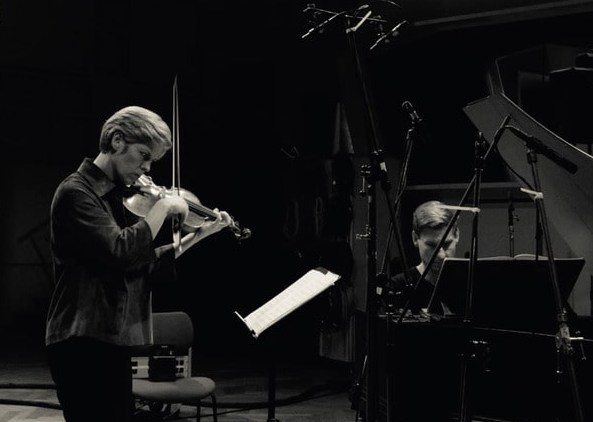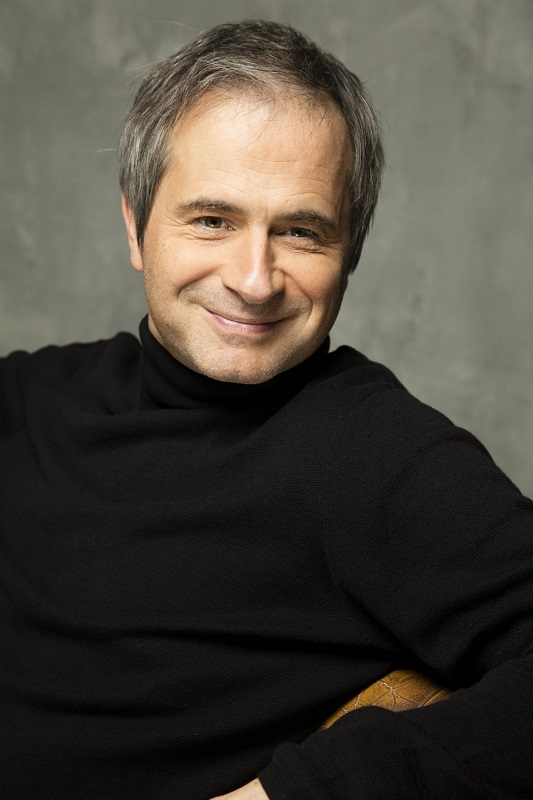Schumann Series 3 & 4, LSO, Gardiner, Barbican review - upstanding brilliance | reviews, news & interviews
Schumann Series 3 & 4, LSO, Gardiner, Barbican review - upstanding brilliance
Schumann Series 3 & 4, LSO, Gardiner, Barbican review - upstanding brilliance
Energetic symphonies cycle concludes, with top soloists in Mendelssohn and Beethoven

Schumann revitalized by John Eliot Gardiner and the London Symphony Orchestra last year left us wanting more: namely two of the four symphonies (transcendently great, as it turns out from these revelatory performances).
The extra energy and communication Gardiner gets from having all the players bar cellos, basses and timps standing – an idea expanded from Mendelssohn the conductor’s practice in Leipzig of keeping violins and violas on their feet – are never for a moment in doubt. We also heard how it gave a spark even more brilliant than usual to Berlioz’s Overture Le Corsaire in a Prom last summer with Gardiner’s period-instrument band, the Orchestre Révolutionnaire et Romantique. Thursday night’s opener, Weber’s Overture to Euryanthe, sounded oddly Berliozian in its dash, too. Then it was discretion time, the orchestra sitting for the first of the two concertos with the best possible soloists. Even at 14 Mendelssohn was straining at the leash, and his Concerto for Violin and Piano has big ambitions, even if it’s a relief that he condensed the forms of later works in the form.
 The first movement would stand as a fantasia by itself: there’s a very surprising moment where the violin takes off against piano tremolos. The rest is more Mozart than Beethoven, but with violinist Isabelle Faust and Kristian Bezuidenhout (pictured right recording for Harmonia Mundi) drawing lovely sounds from a mellow, mezzo-ish forepiano, the creativity was in the teamwork. Mendelssohn the boy wonder clearly got excited by arpeggios; with Bezuidenhout’s perfect timing, we could discover them afresh, too. Faust is for so many of us the perfect violinist – never forcing the sound, adjusting vibrato to the occasion, delightfully in tune with pianist, conductor and orchestra. This is not a work I’d especially want to sit through again in concert with any other soloists, but these two made total musical sense of it.
The first movement would stand as a fantasia by itself: there’s a very surprising moment where the violin takes off against piano tremolos. The rest is more Mozart than Beethoven, but with violinist Isabelle Faust and Kristian Bezuidenhout (pictured right recording for Harmonia Mundi) drawing lovely sounds from a mellow, mezzo-ish forepiano, the creativity was in the teamwork. Mendelssohn the boy wonder clearly got excited by arpeggios; with Bezuidenhout’s perfect timing, we could discover them afresh, too. Faust is for so many of us the perfect violinist – never forcing the sound, adjusting vibrato to the occasion, delightfully in tune with pianist, conductor and orchestra. This is not a work I’d especially want to sit through again in concert with any other soloists, but these two made total musical sense of it.
After that, the concision and originality of Schumann’s “Rhenish” Symphony really struck home. Unusual to have five movements, four of them almost divertimento-like, the bigger opening movement making the most of its bracing, forward-sweeping main theme and transforming it beautifully; we’re in E flat major, a key much favouring the horns since Beethoven’s “Eroica”; Gardiner and Schumann gave them their head, gloriously so. It was mostly rather loud in the treacherously magnifying space of the Barbican Hall, more so than in last year’s two instalments; understood, Gardiner wanted an earthier edge to the ensuing country waltz, but the grace of his ORR recording is somehow more beguiling. Full marks, though, to the delicacy of clarinets in the exquisite little intermezzo, the gone-too-soon feeling induced immediately after its subtle dissolve, the ensuing Bach-like sobriety of a ceremony in Cologne Cathedral, also much shorter and more compact than such rituals tend to be, the delight in the plunge back into the finale’s daylight.

The most ecstatic was saved for last: a perfectly sprung “Spring” Symphony, Schumann's pulsing rhythms so bracingly defined, the melodies singing out (especially the lovely one introduced by the oboe as counterpoint in the first-movement development). Gardiner’s vivid continuity was a virtue in the scherzo with two trios, and violins took advantage of being on their feet to trip the light fantastic in that loving finale (none other, surely, has the marking Allegro animato e grazioso). Nor was it any hardship to sit through the Mendelssohn scherzo again. The main thing, though, is that Gardiner has taken us through the Schumann symphonies as I never heard them before, made us marvel at all their extra generosities of idea and – yes – vindicated his assertion that Schumann was, contrary to the dreary cliché that he couldn’t orchestrate, a master of instrumental means to ends.
rating
Share this article
The future of Arts Journalism
You can stop theartsdesk.com closing!
We urgently need financing to survive. Our fundraising drive has thus far raised £49,000 but we need to reach £100,000 or we will be forced to close. Please contribute here: https://gofund.me/c3f6033d
And if you can forward this information to anyone who might assist, we’d be grateful.

Subscribe to theartsdesk.com
Thank you for continuing to read our work on theartsdesk.com. For unlimited access to every article in its entirety, including our archive of more than 15,000 pieces, we're asking for £5 per month or £40 per year. We feel it's a very good deal, and hope you do too.
To take a subscription now simply click here.
And if you're looking for that extra gift for a friend or family member, why not treat them to a theartsdesk.com gift subscription?
more Classical music
 Solomon, OAE, Butt, QEH review - daft Biblical whitewashing with great choruses
Even a top soprano and mezzo can’t make this Handel paean wholly convincing
Solomon, OAE, Butt, QEH review - daft Biblical whitewashing with great choruses
Even a top soprano and mezzo can’t make this Handel paean wholly convincing
 Two-Piano Gala, Kings Place review - shining constellations
London Piano Festival curators and illustrious friends entertain and enlighten
Two-Piano Gala, Kings Place review - shining constellations
London Piano Festival curators and illustrious friends entertain and enlighten
 Echo Vocal Ensemble, Latto, Union Chapel review - eclectic choral programme garlanded with dance
Beautiful singing at the heart of an imaginative and stylistically varied concert
Echo Vocal Ensemble, Latto, Union Chapel review - eclectic choral programme garlanded with dance
Beautiful singing at the heart of an imaginative and stylistically varied concert
 Scott, Irish Baroque Orchestra, Whelan, RIAM, Dublin review - towards a Mozart masterpiece
Characteristic joy and enlightenment from this team, but a valveless horn brings problems
Scott, Irish Baroque Orchestra, Whelan, RIAM, Dublin review - towards a Mozart masterpiece
Characteristic joy and enlightenment from this team, but a valveless horn brings problems
 Classical CDs: Voice flutes, flugelhorns and froth
Baroque sonatas, English orchestral music and an emotionally-charged vocal recital
Classical CDs: Voice flutes, flugelhorns and froth
Baroque sonatas, English orchestral music and an emotionally-charged vocal recital
 Kanneh-Mason, Britten Sinfonia, Shave, Milton Court - a grin and a big beaming smile
A pair of striking contemporary pieces alongside two old favourites
Kanneh-Mason, Britten Sinfonia, Shave, Milton Court - a grin and a big beaming smile
A pair of striking contemporary pieces alongside two old favourites
 theartsdesk at the New Ross Piano Festival - Finghin Collins’ musical rainbow
From revelatory Bach played with astounding maturity by a 22 year old to four-hand jazz
theartsdesk at the New Ross Piano Festival - Finghin Collins’ musical rainbow
From revelatory Bach played with astounding maturity by a 22 year old to four-hand jazz
 First Person: Manchester Camerata's Head of Artistic Planning Clara Marshall Cawley on questioning the status quo
Five days of free events with all sorts of audiences around Manchester starts tomorrow
First Person: Manchester Camerata's Head of Artistic Planning Clara Marshall Cawley on questioning the status quo
Five days of free events with all sorts of audiences around Manchester starts tomorrow
 Goldscheider, Brother Tree Sound, Kings Place review - music of hope from a young composer
Unusual combination of horn, strings and electronics makes for some intriguing listening
Goldscheider, Brother Tree Sound, Kings Place review - music of hope from a young composer
Unusual combination of horn, strings and electronics makes for some intriguing listening
 theartsdesk Q&A: composer Donghoon Shin on his new concerto for pianist Seong-Jin Cho
Classical music makes its debut at London's K-Music Festival
theartsdesk Q&A: composer Donghoon Shin on his new concerto for pianist Seong-Jin Cho
Classical music makes its debut at London's K-Music Festival

Add comment